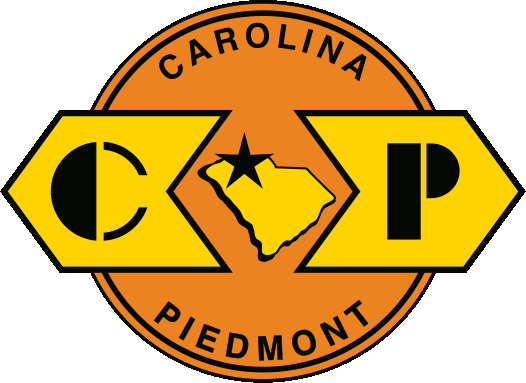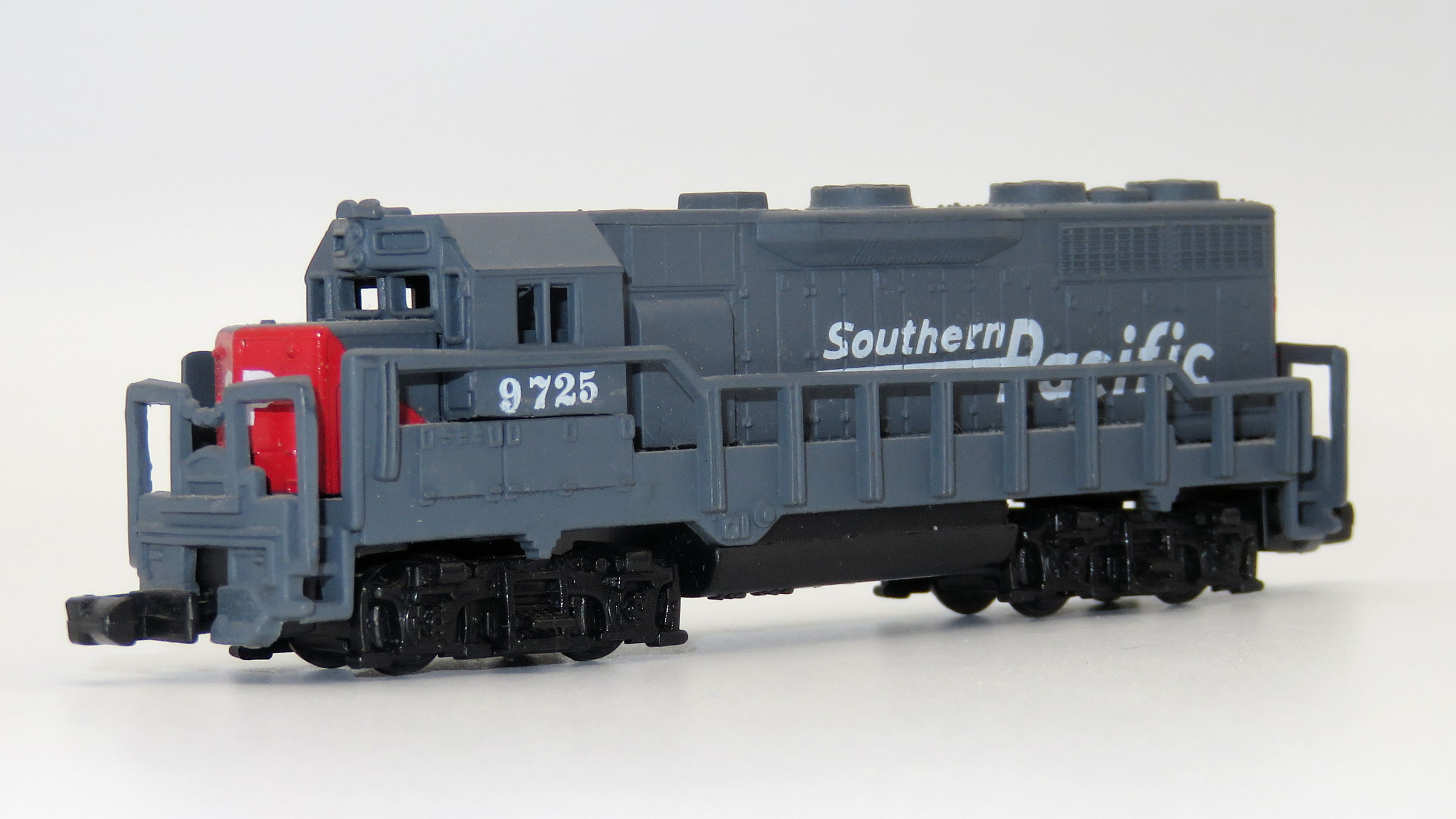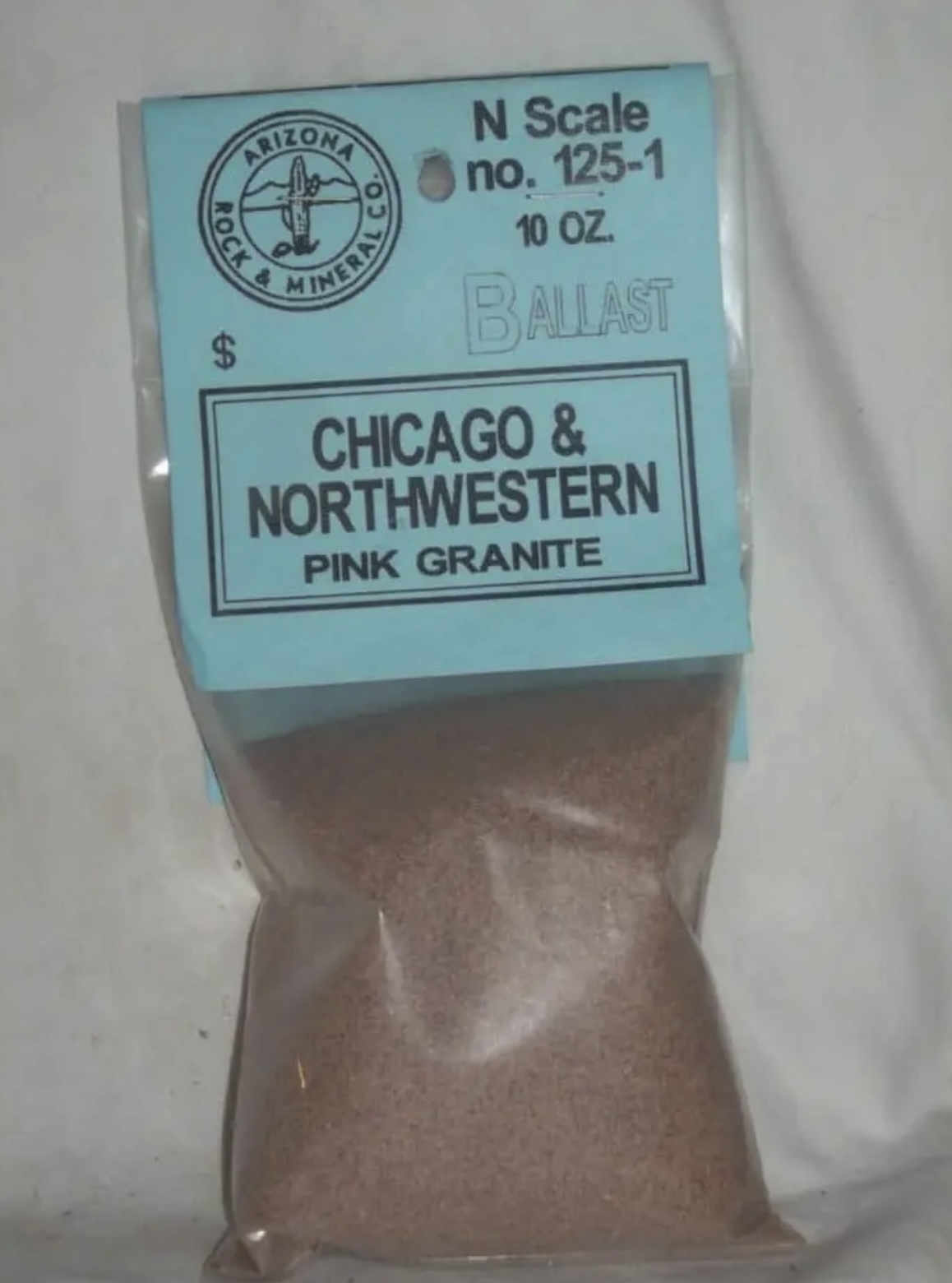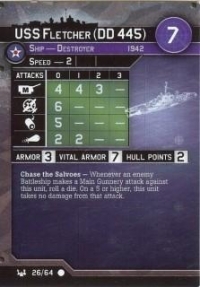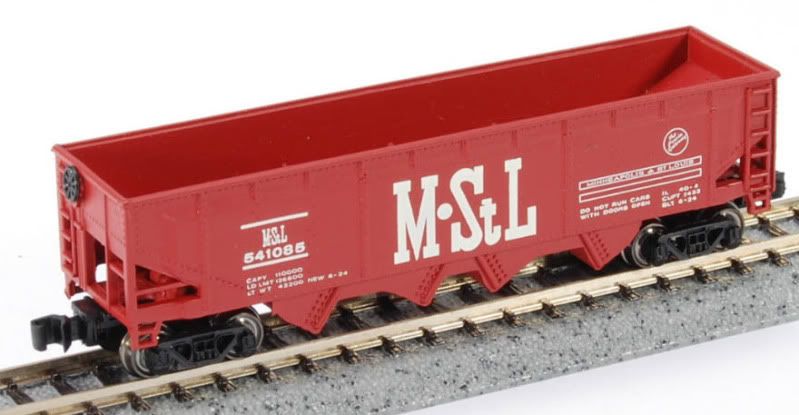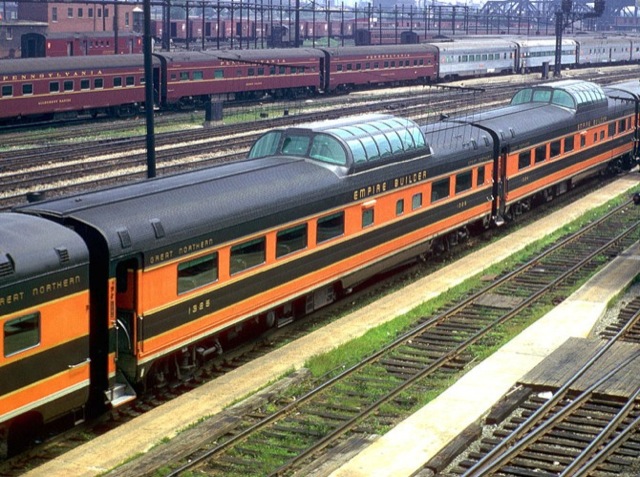Con-Cor - 1-04061X - Passenger Car, Lightweight, Smoothside Vista Dome - Chesapeake & Ohio
| Stock Number | 1-04061X |
| Original Retail Price | $14.00 |
| Brand | Con-Cor |
| Manufacturer | Con-Cor |
| Body Style | Con-Cor Passenger Smoothside 85 Foot Dome |
| Prototype Vehicle | Passenger Car, Lightweight, Smoothside Vista Dome (Details) |
| Road or Company Name | Chesapeake & Ohio (Details) |
| Paint Color(s) | Silver & Blue with Yellow Stripes |
| Print Color(s) | Blue |
| Coupler Type | Rapido Hook |
| Coupler Mount | Truck-Mount |
| Wheel Type | Chemically Blackened Metal |
| Wheel Profile | Standard |
| Release Date | 1991-01-01 |
| Item Category | Passenger Cars |
| Model Type | Lightweight/Streamlined |
| Model Subtype | Smoothside |
| Model Variety | 85 Foot Mid-Train Vista Dome |
| Prototype Region | North America |
| Prototype Era | NA Era III: Transition (1939 - 1957) |
| Scale | 1/160 |
Model Information:
This car is a bit of an odd-ball. It was apparently originally made in the 1970s by Kato for Con-Cor. Early examples are labeled Sekisui/Con-Cor Japan. Later examples have the label milled out and replaced with 'Con-Cor'. This would presume that the tooling was moved from Japan to the United states at some point.
Early versions came in kit form with Rapido couplers. Later versions are Ready-to-Run (RTR) and come with either dummy knuckle "Rigid Face" couplers or Micro-Trains couplers.
It is modeled after the 46-seat dome-coach built by Budd for the CB&Q (Burlington Route) in 1956 to run on the Denver Zephyr. It is very similar to the 46-seat dome-coach built by Budd for Great Northern’s 1955 Empire Builder, the latter having “slab panel” sides instead of corrugated sides.
Despite the model having corrugated sides, Con-Cor marketed and packaged it either as a 'Corrugated Dome' (stainless steel finish) or a 'Smoothside Dome' (painted finish). The Con-Cor literature refers to it as a 'mid-train dome', which means it is not a dedicated tail car and can be used between other passenger cars.
Yet, in spite of the Con-Cor labeling and manufacturing , the Con-Cor website sometimes refers to this model as a 'Rivarossi Corrugated Dome', with a stock number starting with 0003- or 003- that is the company prefix used by Con-Cor for Rivarossi products. This is actually to complement the Rivarossi lightweight corrugated range that is missing a dome car, in particular in the Con-Cor/Rivarossi 5-car corrugated passenger sets.
So, though technical the 'corrugated' and 'smoothside' versions are the same, we have created two different body styles in order to match the Con-Cor denominations.
Warning: Con-cor designed subsequently another mid-train corrugated dome, inspired by another Budd dome built for the California Zephyr, that is not to be confused with this one.
Early versions came in kit form with Rapido couplers. Later versions are Ready-to-Run (RTR) and come with either dummy knuckle "Rigid Face" couplers or Micro-Trains couplers.
It is modeled after the 46-seat dome-coach built by Budd for the CB&Q (Burlington Route) in 1956 to run on the Denver Zephyr. It is very similar to the 46-seat dome-coach built by Budd for Great Northern’s 1955 Empire Builder, the latter having “slab panel” sides instead of corrugated sides.
Despite the model having corrugated sides, Con-Cor marketed and packaged it either as a 'Corrugated Dome' (stainless steel finish) or a 'Smoothside Dome' (painted finish). The Con-Cor literature refers to it as a 'mid-train dome', which means it is not a dedicated tail car and can be used between other passenger cars.
Yet, in spite of the Con-Cor labeling and manufacturing , the Con-Cor website sometimes refers to this model as a 'Rivarossi Corrugated Dome', with a stock number starting with 0003- or 003- that is the company prefix used by Con-Cor for Rivarossi products. This is actually to complement the Rivarossi lightweight corrugated range that is missing a dome car, in particular in the Con-Cor/Rivarossi 5-car corrugated passenger sets.
So, though technical the 'corrugated' and 'smoothside' versions are the same, we have created two different body styles in order to match the Con-Cor denominations.
Warning: Con-cor designed subsequently another mid-train corrugated dome, inspired by another Budd dome built for the California Zephyr, that is not to be confused with this one.
Prototype History:
The Vista-Dome is a deluxe coach with a glass compartment rising out of the roof. This railroad passenger car has a second floor with 24 or 30 seats, lots of windows and no obstructions. The front and rear walls of the dome are windows. The entire side of the dome is made of windows. Curved glass is used to transition from the side to the roofing on vista-domes. All of this glass allows passengers to view the all the great and vast scenery. At night only the only lights used are to illuminate the floor allowing passengers to look up and watch for falling stars. A Vista-Dome has only one set of stairs up and down. It is not the place to hide from a ticket collecting conductor.
The Chicago Burlington & Quincy Railroad, the Burlington Railroad, introduced the Vista-Dome passenger car into regular service in 1947 on it's Twin Zephyr train. It was part of the standard equipment of the California Zephyr train when that train started running on March 20, 1949. The Twin Cities Zephyr train included 5 Vista-Dome cars. Standard height dome cars, 24 inches over the roofline were not suitable for service on most eastern railroads because of clearance problems. Budd built domes with a 19 1/2 inch dome top for eastern service. The Baltimore and Ohio Railroad was the only pre-Amtrak east coast railroad that had Vista-Domes in revenue service. The domes were a part of the Columbian and Capitol trains.
More photos on this website.
The Chicago Burlington & Quincy Railroad, the Burlington Railroad, introduced the Vista-Dome passenger car into regular service in 1947 on it's Twin Zephyr train. It was part of the standard equipment of the California Zephyr train when that train started running on March 20, 1949. The Twin Cities Zephyr train included 5 Vista-Dome cars. Standard height dome cars, 24 inches over the roofline were not suitable for service on most eastern railroads because of clearance problems. Budd built domes with a 19 1/2 inch dome top for eastern service. The Baltimore and Ohio Railroad was the only pre-Amtrak east coast railroad that had Vista-Domes in revenue service. The domes were a part of the Columbian and Capitol trains.
More photos on this website.
Road Name History:
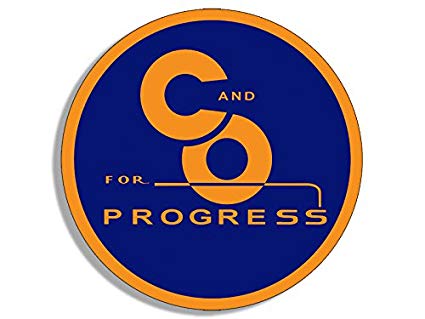 The Chesapeake and Ohio Railway (reporting marks C&O, CO) was a Class I railroad formed in 1869 in Virginia from several smaller Virginia railroads begun in the 19th century. Led by industrialist Collis P. Huntington, it reached from Virginia's capital city of Richmond to the Ohio River by 1873, where the railroad town (and later city) of Huntington, West Virginia was named for him.
The Chesapeake and Ohio Railway (reporting marks C&O, CO) was a Class I railroad formed in 1869 in Virginia from several smaller Virginia railroads begun in the 19th century. Led by industrialist Collis P. Huntington, it reached from Virginia's capital city of Richmond to the Ohio River by 1873, where the railroad town (and later city) of Huntington, West Virginia was named for him.
Tapping the coal reserves of West Virginia, the C&O's Peninsula Extension to new coal piers on the harbor of Hampton Roads resulted in the creation of the new City of Newport News. Coal revenues also led the forging of a rail link to the Midwest, eventually reaching Columbus, Cincinnati and Toledo in Ohio and Chicago, Illinois.
By the early 1960s the C&O was headquartered in Cleveland, Ohio, USA. In 1972, under the leadership of Cyrus Eaton, it became part of the Chessie System, along with the Baltimore and Ohio and Western Maryland Railway. The Chessie System was later combined with the Seaboard Coast Line and Louisville and Nashville, both the primary components of the Family Lines System, to become a key portion of CSX Transportation (CSXT) in the 1980s. A substantial portion of Conrail was added in 1999.
C&O's passenger services ended in 1971 with the formation of Amtrak. Today Amtrak's tri-weekly Cardinal passenger train follows the historic and scenic route of the C&O through the New River Gorge in one of the more rugged sections of the Mountain State. The rails of the former C&O also continue to transport intermodal and freight traffic, as well as West Virginia bituminous coal east to Hampton Roads and west to the Great Lakes as part of CSXT, a Fortune 500 company which was one of seven Class I railroads operating in North America at the beginning of the 21st century.
At the end of 1970 C&O operated 5067 miles of road on 10219 miles of track, not including WM or B&O and its subsidiaries.
Read more on Wikipedia.

Tapping the coal reserves of West Virginia, the C&O's Peninsula Extension to new coal piers on the harbor of Hampton Roads resulted in the creation of the new City of Newport News. Coal revenues also led the forging of a rail link to the Midwest, eventually reaching Columbus, Cincinnati and Toledo in Ohio and Chicago, Illinois.
By the early 1960s the C&O was headquartered in Cleveland, Ohio, USA. In 1972, under the leadership of Cyrus Eaton, it became part of the Chessie System, along with the Baltimore and Ohio and Western Maryland Railway. The Chessie System was later combined with the Seaboard Coast Line and Louisville and Nashville, both the primary components of the Family Lines System, to become a key portion of CSX Transportation (CSXT) in the 1980s. A substantial portion of Conrail was added in 1999.
C&O's passenger services ended in 1971 with the formation of Amtrak. Today Amtrak's tri-weekly Cardinal passenger train follows the historic and scenic route of the C&O through the New River Gorge in one of the more rugged sections of the Mountain State. The rails of the former C&O also continue to transport intermodal and freight traffic, as well as West Virginia bituminous coal east to Hampton Roads and west to the Great Lakes as part of CSXT, a Fortune 500 company which was one of seven Class I railroads operating in North America at the beginning of the 21st century.
At the end of 1970 C&O operated 5067 miles of road on 10219 miles of track, not including WM or B&O and its subsidiaries.
Read more on Wikipedia.
Brand/Importer Information:
Con-Cor has been in business since 1962. Many things have changed over time as originally they were a complete manufacturing operation in the USA and at one time had upwards of 45 employees. They not only designed the models,but they also built their own molds, did injection molding, painting, printing and packaging on their models.
Currently, most of their manufacturing has been moved overseas and now they import 90% of their products as totally finished goods, or in finished components. They only do some incidental manufacturing today within the USA.
Important Note: The Con-Cor product numbering can be very confusing. Please see here in the article how to properly enter Con-Cor stock numbers in the TroveStar database.
Currently, most of their manufacturing has been moved overseas and now they import 90% of their products as totally finished goods, or in finished components. They only do some incidental manufacturing today within the USA.
Important Note: The Con-Cor product numbering can be very confusing. Please see here in the article how to properly enter Con-Cor stock numbers in the TroveStar database.
Item created by: james13pugh
on 2022-04-26 14:11:46
If you see errors or missing data in this entry, please feel free to log in and edit it. Anyone with a Gmail account can log in instantly.
If you see errors or missing data in this entry, please feel free to log in and edit it. Anyone with a Gmail account can log in instantly.





